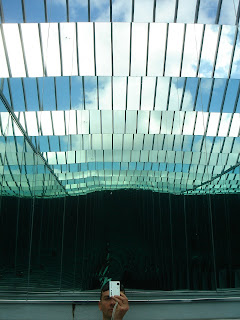 The most visually arresting piece is the installation made out of Lego pieces. It invokes a super
city with skyscrapers in various shapes and attractive combinations of
color.
The most visually arresting piece is the installation made out of Lego pieces. It invokes a super
city with skyscrapers in various shapes and attractive combinations of
color. The installation is a projection of what cities will look like in the future, which feels kind of alienating and nonconducive to human interaction.




Compare the futuristic city with the suburban environment, shown right across from the skyscraper installation, to start a dialogue about urban evolution. This installation is built from Lego kits manufactured for a standard housing model typically seen in suburban settings. In these houses every detail looks exactly the same. In its repetitive monotony and lack of individuality, this type of architecture feels as isolating and alienating as the future vision of the soaring city that stands right across from it.

 Another installation displays found objects that Coupland has collected over the years. In the work above objects with primary colors are neatly arranged in a wall display.
Another installation displays found objects that Coupland has collected over the years. In the work above objects with primary colors are neatly arranged in a wall display. These objects all have one thing in common: They are components for model kits.
These objects all have one thing in common: They are components for model kits.The detail from the installation below shows found objects of Canadiana, objects that, reflects the artist's identity and history.

The next set of paintings are contemporary interpretations of paintings from the Group of Seven artists, Canada's most influential group of artists who produced landscapes with modern techniques in the 1920s. The colorful set of paintings below are abstracted to graphic designs with geometric forms, translating the original Group of Seven paintings to today's contemporary sensibilities.

The black and white paintings go a step further in abstracting the original work through geometric patterns and a monochromatic color palette.
The work above, called the Spectra Four Seasons, is an exploration of light reflected upon the landscape through the changing of the seasons. Upon close inspection, the work reveals itself as a set of pencil crayons inside an acrylic case.
This work abstracts the Group of Seven landscapes further in a whimsical way in a contemporary language.










































